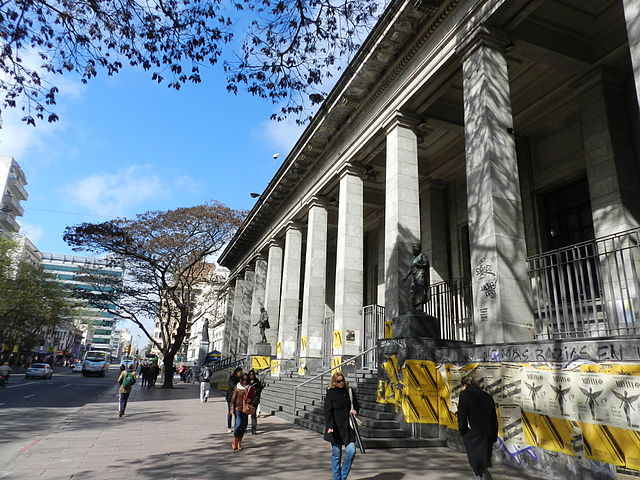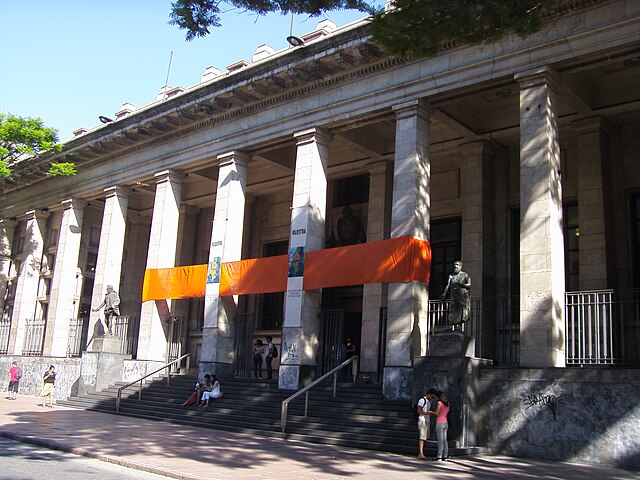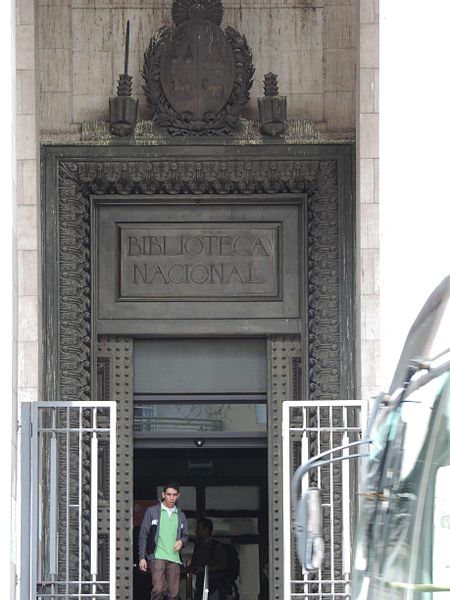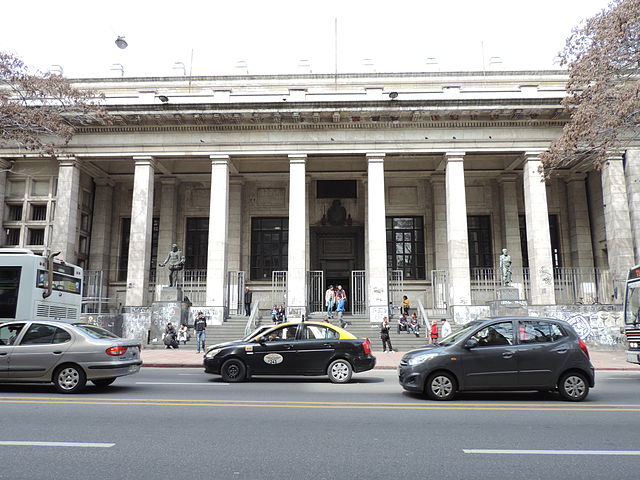National Library of Uruguay
The Biblioteca Nacional de Uruguay (National Library of Uruguay) was founded in 1815, so last year it celebrated its 200th anniversary. It is located in Montevideo, the nation’s capital, with a population of over 1,300,000 people. The library contains around one million books and 20,000 periodicals. Its director, Professor Esther Pailos Vázquez, told local media:
We have in our stock all Uruguayan authors, but also in the literary archive is everything that has to do with the manuscripts of 140 Uruguayan authors and their personal belongings… [The] Library should become a model institution, referenced in the region and the world as a paradigm to emulate.
The Thammasat University Libraries own books about Uruguay, its agricultural development, and its relationship to the United Nations, among other subjects. The TU Libraries collection also contains works by such noted Uruguayan authors as Eduardo Galeano, a journalist, novelist, and football enthusiast. Also available are poems by Mario Benedetti, a noted Uruguayan author, among other works. Readers of these and other books by Uruguayan writers will know why the celebrations of the National Library’s bicentenary were held under the overall title, Uruguay, Country of Thought.
Films festivals, special gala performances and specially issued stamps and coins were also part of the festivities. Earlier this months, the celebrations traveled to Cuba, where Uruguay was guest of honor at the XXV Book Fair of Havana. The National Library of Uruguay’s Special Materials Room is of particular interest, with rare books dating back to the 1500s and copies of early local newspapers such as The Southern Star, founded in 1807. Its neoclassical building, designed by the Spanish architect Luis Crespi González, opened in 1964. Whereas Dámaso Antonio Larrañaga (1771–1848), a Uruguayan priest, naturalist and botanist called for a public library to be founded in 1815, the resulting collection officially opened on May 26, 1816. In an interview with local news media, Professor Pailos Vázquez stated:
We want a more open and visible National Library…[the library] is more relevant than ever. We are the oldest cultural institution in Uruguay. The Library has followed the vicissitudes of the country… we also have 80,000 Uruguayan authors in an online catalog. We also have digital collections of photos, posters, maps, etc., and our primary mission is to conserve the bibliographic heritage.
To celebrate the library’s bicentenary, lectures, poetry readings, and theater entertained audiences. A chess tournament was held as well.
Thailand and Uruguay
The Uruguayan Consulate in Bangkok is located on New Petchburi Road, Huai Khwang, Bang Kapi, Bangkok. Mrs. Netra Ruthaiyanont, Consul, is the only Uruguayan representation in Thailand. Thailand maintains a consulate general in Montevideo. Last year The Nation reported on a tour to Bangkok by the National Ballet of Uruguay (Ballet Nacional Sodre or BNS). This troupe was founded in 1935, and regularly makes international visits to show its mastery of classical dance repertoire.
Learning from Uruguay.
On a different subject, a blogger for ethailand.com asked in January if Uruguay might be a model for Thailand in its adoption of solar power. Last year Thailand’s Ministry of Energy declared its intention to reduce the national dependence on imported fuels with the Alternative Energy Development Plan (AEDP). By the year 2035, the target is to achieve a 170% increase in alternative energy capacity. Uruguay has already been down this road, as the blogger Larry Banks explained:
In 2000, oil was Uruguay’s biggest import – representing 27% of the country’s total. That number one rank now belongs to wind turbines. Ramón Méndez, Uruguay’s head of climate change policy, claims that 94.5% of the country’s electricity today comes from renewables. According to Méndez, Uruguay’s success has come through clear decision-making, a supportive regulatory environment and a strong partnership between the public and private sectors. In other words something that, with political will, practically any country can replicate. “What we’ve learned is that renewables is just a financial business,” Méndez says. “The construction and maintenance costs are low, so as long as you give investors a secure environment, it is very attractive.” This shift has kick-started major investment in renewable energy and liquid gas in Uruguay. Over the last five years such investment has risen sharply to USD 7 bn (THB 252 bn) which represents 15% of the country’s annual GDP Consequently, this nation of just 3.4 million people is a pioneer amongst Latin American countries with five times the average investment rate in the region and three times the global share recommended by climate economist Nicholas Stern… Along with wind power, a developed hydropower industry, as well as an increased biomass and solar energy sectors, renewables today make up 55% of Uruguay’s total energy mix. In fact mix is the critical word here: whilst other small countries such as Paraguay, Bhutan and Lesotho rely heavily on hydropower and Iceland is geared towards geothermal energy, Uruguay’s renewable energy sources are more varied. This makes the country less vulnerable to changes in climate.
All Thai people aware of environmental challenges would be interested to know if a similar success story was possible for Thailand. Whereas renewables today make up 55% of Uruguay’s total energy mix, the world average is currently just 12%. In 2013 in Thailand, energy consumption included only 11.3% of renewables. The Ministry of Energy’s AEDP aims to increase that percentage to 25% by 2021. Uruguay did not seek high tech innovation to achieve its new energy balance, with no nuclear power or new hydroelectric power. Instead, like Uruguay, Thailand might be able to rely on solar power. In 2014, 17% of Thailand’s renewable energy came from the sun, and the AEDP hopes to increase this to 30%. While there are signs that Thailand is taking solar power seriously, Larry Banks argues, further progress can be made in following the Uruguayan model to create a balance of different renewable energy sources, instead of relying mostly or entirely on the sun. Last year, GE Renewable Energy announced a new contract to provide wind turbines to northern Thailand, enough to provide energy for around 36,000 homes annually. Wind power and other sources can be used to build a better future, just as Uruguay has done for its people.
(All images courtesy of Wikimedia Commons).




